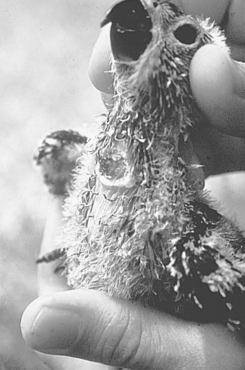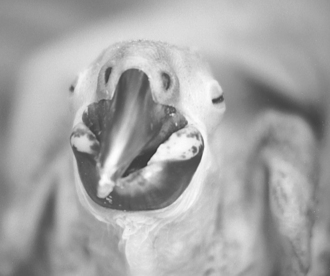Chapter 27 Diseases of the Digestive System
The digestive system of the bird is different from that of mammals. Birds have no teeth for cutting and grinding food. The esophagus, found on the right side of the neck in birds, contains a dilated portion called the crop used for food storage, allowing the bird to eat fast and travel. From the crop the food passes into the proventriculus (the glandular stomach), the ventriculus (the gizzard or grinding stomach), and then into the small intestine. After traveling through the small intestine, large intestine, and colon, the feces pass into the cloaca. Because the renal and reproductive tracts also empty into the cloaca, feces are excreted mixed with urine and urates. Disturbances of the digestive system are among the most common problems of captive birds.
Crop Stasis
Primary causes of crop stasis are:
Crop Burns
Crop burns occur when owners feed diets that are heated to extreme temperatures. This primarily is a result of using a microwave for heating the diet. Microwaves produce high heat areas in the middle of the food, leaving cooler areas at the surface and sides of the container. If the food is not well mixed after heating, the very hot food may be placed into the crop, causing a severe burn. The damaged tissue will become necrotic and slough, often leaving a fistula in the crop (Fig. 27-1).

Figure 27-1 Crop burn with necrosis in a young hand-fed bird.
(From Altman RB, Clubb SL, Dorrestein GM, Quesenberry KE: Avian medicine and surgery, Philadelphia, 1997, WB Saunders, by permission.)
Beak Deformities
Malformed beaks (Fig. 27-2) are the result of trauma, malnutrition, improper hand-feeding techniques, mite infestation, bacterial or viral disease, or liver dysfunction. Whatever the cause, a malformed beak may result in an inability to eat properly and digestive problems. Beak deformation in young hand-fed birds once thought to be related to hand-feeding from a single side of the beak is more likely related to poor nutritional balances in the hand-feeding diet. In older birds, trauma to the germinal tissue of the beak will cause permanent beak deformities similar to those seen with damage to the cuticle of the fingernail or coronary band of the hoof. Mite infestation with Knemidokoptes can also result in damage to the beak, resulting in deformities that are seen primarily in parakeets.

Figure 27-2 Lateral deviation of the maxilla in a macaw.
(From Altman RB, Clubb SL, Dorrestein GM, Quesenberry KE: Avian medicine and surgery, Philadelphia, 1997, WB Saunders, by permission.)
TREATMENT
Treatment will depend on the cause of the malformation.



